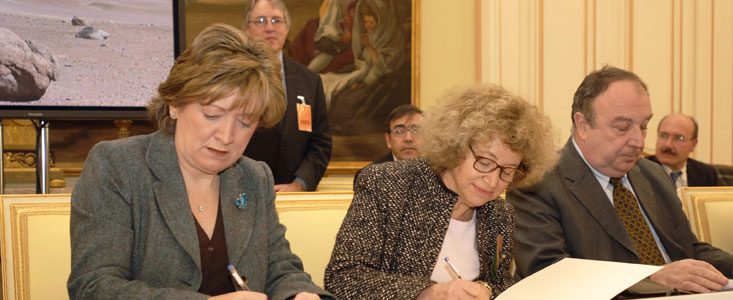Press Release
Spain to Join ESO
ESO Will Welcome its 12th Member State on 1 July 2006
13 February 2006
Today, during a ceremony in Madrid, an agreement was signed by the Spanish Minister of Education and Science, Mrs. María Jesús San Segundo, and the ESO Director General, Dr. Catherine Cesarsky, affirming their commitment to securing Spanish membership of ESO.
Following approval by the Spanish Council of Ministers and the ratification by the Spanish Parliament of the ESO Convention and the associated protocols, Spain intends to become ESO's 12th member state on 1 July 2006.
"Since long Spain was aware that entering ESO was a logical decision and it was even necessary for a country like Spain because Spain is ranked 8th in astrophysical research", said Mrs. María Jesús San Segundo. "The large scientific installations are not only necessary for research in different fields but are also partners and customers for hi-tech companies, helping to increase the funding of R&D."
"Spanish Astronomy has made tremendous strides forward and we are delighted to welcome Spain as a new member of ESO. We very much look forward to working together with our excellent Spanish colleagues," said Dr. Cesarsky. "For ESO, the Spanish accession means that we can draw on the scientific and technological competences, some of them unique in Europe, that have been developed in Spain and, of course, for Europe the Spanish membership of ESO is an important milestone in the construction of the European Research Area."
Indeed, Spain is an important member of the European astronomical community and has developed impressively over the last three decades, reaching maturity with major contributions in virtually all subjects of astronomy. In addition, Spain hosts, operates or owns a number of competitive facilities dedicated to foster astronomical research, among which the Observatorio del Roque de los Muchachos at La Palma, certainly the premier optical/infrared astronomical observing site in Europe and site of the Spanish 10m GranTeCan telescope now nearing completion.
With the high quality of Spanish astronomical research as well as the technological competence of Spanish industry, it is only fitting that Spain should join ESO, world-leader in ground-based astronomy. Through ESO Spain will enjoy full access both to all of ESO's current facilities and to unrestricted participation in the great projects that ESO is planning for the future. Spain is already an active partner of the Atacama Large Millimeter Array (ALMA), whose construction and operations are led on behalf of Europe by ESO.
ESO's Council approved the admission of Spain at its 107th meeting held in Garching on 7 and 8 December 2005.
Notes
ESO is the intergovernmental European research organisation for Astronomy in the Southern Hemisphere. It is supported by Belgium, Denmark, Finland, France, Germany, Italy, the Netherlands, Portugal, Sweden, Switzerland and the United Kingdom.
ESO operates the La Silla Paranal Observatory. At the Paranal site it runs the world's prime optical/infrared astronomical facility, the Very Large Telescope Array (VLT). Located 130 km south of Antofagasta, this 2,600 m high mountain is in the driest part of the Atacama desert. The VLT consists of four 8.2-metre and four 1.8-metre telescopes. Several of the telescopes can be used in combination as a unique, giant interferometer (Very Large Telescope Interferometer, VLTI). In addition, ESO operates the La Silla site, 600 km north of Santiago de Chile, at 2,400 m altitude where state-of-the-art medium-sized telescopes are in operation. More than 1600 proposals are made each year for the use of the ESO telescopes.
The ESO Headquarters are located in Garching, near Munich, Germany. This is the scientific, technical and administrative centre of ESO where technical development programmes are carried out to provide the Observatory with the most advanced instruments. There are also extensive astronomical data facilities. ESO is currently engaged in a major new project for the construction of an array of telescopes for observation in the mm/sub-mm wavelength domain. Known as the Atacama Large Millimeter Array (ALMA), this is a joint European/North American/Japanese project, due for completion in 2012. Furthermore, studies for an extremely large optical telescope are being undertaken by ESO and its collaborating institutes.
The ESO Convention was established in 1962 and specifies the goals of ESO and the means to achieve these, e.g., "The Governments of the States parties to this convention... desirous of jointly creating an observatory equipped with powerful instruments in the Southern hemisphere and accordingly promoting and organizing co-operation in astronomical research..." (from the Preamble to the ESO Convention).
Contacts
Claus Madsen
ESO
Garching, Germany
Tel: +49 89 3200 6278
Cell: +49 171 95 25 603
Email: cmadsen@eso.org
Henri Boffin
ESO
Garching, Germany
Tel: +49 89 3200 6222
Email: hboffin@eso.org


